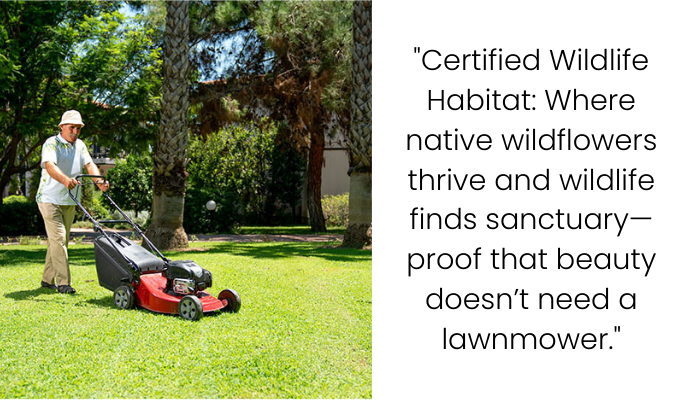Nosy Neighbor Complains About Weeds So Couple Transforms Yard Into Wildlife Sanctuary
In a quiet neighborhood, a homeowner’s commitment to ecological landscaping became the center of an unexpected dispute. Embracing a vision of sustainability, the yard was transformed into a haven for native flora and fauna, featuring drought-resistant plants like Lupine, Blue Flax, Spiderwort, Black-eyed Susan, and Sunflowers. Natural elements such as driftwood logs and even an elk skull were thoughtfully placed to support local wildlife.
However, this unconventional approach drew the ire of a neighbor, who lodged numerous complaints with the county, alleging violations of local ordinances concerning overgrown vegetation. Upon investigation, it was revealed that the yard was in full compliance, with all plantings being purposeful and non-invasive. To solidify their stance and promote environmental stewardship, the homeowner sought and obtained certification from the National Wildlife Federation, officially designating the yard as a Certified Wildlife Habitat. This move not only validated their landscaping choices but also provided a robust defense against further complaints.
Some people put a lot of effort and take great pride in keeping their yard just the way they want it

But that doesn’t mean their neighbors are going to appreciate it











🌿 Embracing Native Landscaping
The homeowner’s yard exemplifies the principles of native landscaping, which emphasizes the use of indigenous plants to create sustainable and wildlife-friendly environments. Plants like Lupinus perennis (Wild Lupine) and Rudbeckia hirta (Black-eyed Susan) are not only aesthetically pleasing but also play crucial roles in supporting local ecosystems. For instance, Wild Lupine is essential for the survival of the endangered Karner blue butterfly, serving as its primary larval food source .
By cultivating such native species, homeowners contribute to biodiversity, reduce the need for chemical fertilizers and pesticides, and promote resilience against pests and diseases. Moreover, native plants are typically well-adapted to local climate conditions, reducing water usage and maintenance efforts.
🏛 Navigating Local Regulations
Despite the ecological benefits, naturalistic yards can sometimes clash with local ordinances that favor manicured lawns. Many municipalities have regulations addressing overgrown vegetation, often defined by specific height restrictions or the presence of certain weed species. However, these ordinances typically distinguish between neglected properties and those intentionally cultivated with native plants.
In the case at hand, the homeowner proactively reviewed local codes and ensured compliance by maintaining purposeful plantings that did not encroach on public pathways or neighboring properties. Engaging with county officials and providing documentation of the yard’s intentional design were key steps in resolving the dispute.

🛡 Certification as a Strategic Defense
Obtaining certification from the National Wildlife Federation served as both a validation of the homeowner’s efforts and a strategic defense against ongoing complaints. The certification process requires properties to provide food, water, cover, and places for wildlife to raise young, all achieved through sustainable practices .
Displaying the Certified Wildlife Habitat sign not only educates passersby about the yard’s purpose but also signals to authorities and neighbors that the landscaping choices are deliberate and environmentally beneficial. This recognition can be instrumental in mitigating conflicts and fostering community appreciation for ecological initiatives.
But people loved that the busybody didn’t get their way








